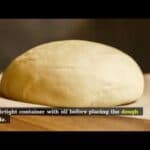After you have the recipe and all the ingredient for making bread, including flour, sugar, and yeast, what size mixing bowl should you use for bread dough? We asked some avid bakers how the mixing bowl’s size can improve your bread-making experience.
When it comes to mixing bowls for bread making, most bakers agree that bigger is better! For the best results, you should use your largest mixing bowl so that you can easily mix the ingredients and knead the dough. Large mixing bowls range in size from 4 to 10 quarts – not practical for daily use but perfect for baking projects.
Now that you have a large mixing bowl ready, stay with us for a few more essential bread-making tips. We will discuss the best mixing bowl materials for dough and storage containers for sourdough starter. You can proof the bread dough right in the mixing bowl for less mess and hassle!
Each baker varies his or her method and taste when it comes to breadmaking, which is an age-old craft. The most essential tool when baking bread is a mixing bowl, regardless of how your kitchen is set up. In various shapes and materials, mixing bowls are available. The larger the bowl, the easier it will be to mix ingredients and knead dough for bread. As well, a larger bowl will provide ample rising space when it’s time to prove the dough.
What Type of Bowl is Best for Making Bread?
When it comes to mixing bowls for baking bread, neither stainless steel nor tempered glass beat other materials. Both materials are durable, nonporous, and almost indestructible. Besides their versatility in the kitchen, these glass bowls can be microwaved as well. Plastic and ceramic bowls, on the other hand, can also be useful but tend to be easily damaged. Bowls made of plastic are porous and can retain moisture and oil, potentially intermingling previously mixed flavors with bland bread dough.
Consider the bowl’s weight and stability when choosing a bread bowl. A flat bottom with a rubber or silicone edge is ideal for ensuring a firm grip; a bowl that tips or slides easily won’t be suitable. Because stainless steel is so lightweight, you can even cradle the bowl in one arm to knead bread with the other hand if you want to remove it from the countertop. As you knead in the bowl on the countertop, glass is less likely to wobble or slide.
Stainless steel and glass are both good heat conductors. We’ll discuss this feature later in this post when we talk about proofing your bread in a mixing bowl. You will see your bread rise faster if the bowl is warmer.
How Big of a Container do You Need for Sourdough Starter?
As your starter quantity rises, sometimes more than twice as much as the original amount, and then depreciates, sizing a container for sourdough starters can be challenging. This container must be large enough to maintain the rise without overflowing. A container of 8 ounces is perfect for the occasional breadmaker, while a container of 16 to 32 ounces is ideal for an avid baker.
What is the Best Container for Sourdough Starter?
It is best to use glass containers for sourdough since this nonporous material will prevent previous odors or flavors from mixing with the starter — or vice versa if you plan to reuse the container for food storage. Furthermore, glass gives you a clear view of your starter so you can see how it is progressing. In this case, the glass is susceptible to breaking. As a result, be especially cautious that pressure does not build beneath the lid while the starter is fermenting-more on lids later.
It is also possible to use stoneware crocks to contain a sourdough starter, especially if you have a long-lasting starter. Despite being nonporous, this material will not allow you to see inside while the yeast grows and reacts. Crocks are typically equipped with a stoneware or wooden, loosely fitting lid and can hold large quantities of food.
Another viable container material for sourdough starters is BPA-free plastic. The porous nature of these containers will allow them to flex with the fermenting starter without breaking – but they can be difficult to clean and get rid of the sourdough flavor if you intend to reuse them. If you are looking for the best mixing bowls for bread making, we have a recommendation for you!
For starters, choose a tall, bulbous container to give them plenty of space to build. For example, many sourdough enthusiasts prefer the size and shape of a pint glass or mason jar. Using airtight lids isn’t recommended since pressure builds as the yeast ferments, potentially causing the container to break or the lid to pop off, resulting in a messy spill. After feeding, leave the lid loose or cover the container with a shower cap, cloth, saran wrap, or rubber band.
How do You Proof Bread in a Bowl?
A proofing process is used to encourage bread dough to rise before it is baked in the oven. During this process, the yeast in the dough is activated. Carbon dioxide is released during proofing, creating air bubbles throughout the dough – a waste product produced as the yeast digests sugar. There are almost as many methods of proofing as there are bread recipes! We’re here, however, to discuss the best way to proof dough in a mixing bowl.
Depending on the type of bread, proofing time will vary. In some recipes, proofing bread for two to four hours is recommended, but in others overnight might be recommended. For the first proof, the dough is typically kneaded or reshaped and allowed to proof again before baking. By adjusting the ambient temperature, you can accelerate or delay the proofing process. Practicing your proofing techniques repeatedly with the same bread recipe and proofing method is the best way to le
Was this helpful?
Hi there! I’m a food enthusiast and journalist, and I have a real passion for food that goes beyond the kitchen. I love my dream job and I’m lucky enough to be able to share my knowledge with readers of several large media outlets. My specialty is writing engaging food-related content, and I take pride in being able to connect with my audience. I’m known for my creativity in the kitchen, and I’m confident that I can be the perfect guide for anyone looking to take their culinary journey to the next level.








